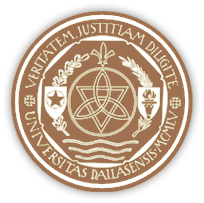Call for Submissions
The editors of Ramify: The Journal of the Braniff Graduate School of Liberal Arts are now accepting articles for volume nine. Articles should treat a topic with intellectual rigor, exhibit clear prose, and ground their discourse in the great works of the Western tradition. The aim of the journal is to foster the involvement of scholars, teachers, and students in the ongoing dialogue within the western tradition, for only by doing so may we take our place as free and grateful heirs to this tradition.
Thus, submissions will be favored that are critical and interpretive rather than analytical and technical, speculative rather than merely practical. A submitted article should aim at original thought, while demonstrating familiarity with relevant perspectives of existing scholarship. Although adhering to the principles of the particular discipline from which it departs, the article should establish the context and importance of its inquiry within broad human concerns, considering its ramifications for a humane life, the body politic, or the western tradition. The article should speak, then, not to the expert alone, but to all intelligent, well-informed readers.
Ramify also welcomes submissions of poems up to 50 lines and translations of literary texts not exceeding 50 lines.
Submission Guidelines
Length: 2,500 to 5,000 words is suggested, though not an absolute limitation.
Abstract: Include a 150–200 word abstract of the article, in the same file.
Style: Chicago, with short footnotes and bibliography.
Deadline: June 30, 2020. Please note that submissions are accepted on a rolling basis for publication at the start of the following academic year.
Article Limit: Each author should submit no more than one article.
Exclusivity: Submitted articles should not be under consideration at other publications.
Format: Files should be in '.doc', '.docx', or '.rtf' format. Include a cover page with your name, the title, and the abstract. Your name should appear only on the cover page.
Submissions should be sent to submissions@ramify.org
Correspondence and questions should be directed to editors@ramify.org
Instructions to Authors
Journal articles are substantially different from class papers.
In order to prepare a superior class paper for submission to the journal, students should modify it according to the following guidelines:
- Explain crucial conceptual terms and contexts, so the article will be accessible to a broad audience. Do not take for granted a reader's familiarity with a text under discussion, but rather provide minimal definitions and contexts.
- Examine a question that has merit in its own right, apart from class emphases.
- Exhibit a breadth of critical view, demonstrated by reference to scholarship. A credible thesis involves a knowledge of critical contexts.
- Fully amplify the argument: it should not be abbreviated in haste toward the end.
Style Suggestions
In addition to using the Chicago Manual of Style, 15th ed. as a reference, we suggest reading or using the following, none of which we adhere to slavishly:
- The Office of Assertion, by Scott Crider
- Fowler's Modern English Usage, Revised and Edited by Sir Ernest Gowers (not the Burchfield edition)
- Modern American Usage, by Wilson Follett (the Barzun ed., not the Wensberg ed.)
- Garner's Modern American Usage
- The Elements of Style, by Strunk and White
- Write Tight, by William Brohaugh
- The Ethics of Rhetoric, by Richard Weaver
- The Trivium: The Liberal Arts of Logic, Grammar, and Rhetoric, by Sister Miriam Joseph
General Approach
-
Focus: Have a clear thesis that is worth proving, and ensure that everything in your essay helps to support your thesis.
Development: Pursue thoughts deeply, and consider important implications. Bring sufficient evidence to bear, and thoroughly analyze quoted passages. Reach for a synthesis of knowledge. Use transitions to show the development of your thoughts.
Organization: Construct each paragraph around a sub-thesis and a conclusion that supports the main thesis. Order paragraphs to reflect the development.
Style: Orient the article toward the well-educated, intelligent, general reader. See the House Style page.
Mechanics: Avoid grammatical mistakes. Use Chicago format for references. - The introduction should establish the human concern of the article: what this particular topic has to do with us—not as academics or specialists, but as human beings. The purpose and point of view of the paper should be clear. The introduction should end (usually) with a clear thesis sentence (see e.g. The Office of Assertion 2.3), and in every case the article should have a discernible thesis.
- Throughout the article do not simply analyze the primary text(s) under consideration, but reach for synthetic knowledge by discussing the implications of your analysis beyond mere understanding or interpretation of the text; do not talk only about what the author says about things; talk about the things themselves. When doing this, make the perspective from which the article is written clear, without stating it woodenly: the rhetoric should reveal what you think is the good, or the true, or the beautiful—or in what direction it lies—and how the text conveys it, or how it fails. Such development might mean, say, for each section explaining what the text says; analyzing it to show what it means, implies, or suggests; and synthesizing this with your own thought to show how the text can help us see the truth (or not). And yes, this means going out on some limbs.
- Typically, each section (of one or several paragraphs) should have its own thesis statement (which in turn contributes to the thesis of the paper as a whole) and conclusion (again, a conclusion is not a summary).
- The conclusion of the article, then, should not merely summarize (yawn…), but rather should reinforce the human concern of the article, and further broaden its scope to discuss the implications of the thesis beyond the limits of the article itself. Assume that you've proven your thesis: so what?
-
Footnotes should be minimal, and there should be few if any 'substantive' or 'discursive' notes (see CMS 16.36,54). If a point develops the argument, put it in the main text. If it is merely an aside that adds nothing to the argument, but might be of interest to the specialist, eliminate it—the audience for the journal is the general reader. Statements or examples in support of the thesis should not be in footnotes: the only 'substantive' notes should be e.g. to direct readers to where they might find more information about something if they wish ('so-and-so covers this topic thoroughly in his article such-and-such'); to summarize scholarly opinion (the typical long note near the beginning that touches on several articles); and such like (as in CMS 16.58).
Often 'discursive' footnotes seem to mark a split in the course of the argument, where one wants to say one thing that leads to further arguments, and also take a different route that doesn't lead in quite the same direction. So, the former is put in the main text, the latter in a footnote. But this practice leaves the reader stranded after reading the footnote. So putting secondary statements in footnotes is simply a way of writing that is not meant to be read. A parenthetical remark can be put in parentheses rather than in a footnote. Or, after an aside, return the reader's mind to the main thread of the argument by briefly referring to the place where you left off. - Don't just quote, analyze. Don't presume that readers will understand the quotation in the same way you do. Quotations should never be stranded without comment, so two quotations should almost never follow each other without intervening analysis, and quotations should usually not end a paragraph.
- Address your paper to the reader skeptical in the proper sense—doubting, but not unable to be convinced: someone of good will who doesn't initially agree with your thesis. Consider the objections, and address them either by writing in such a way as to forestall them or (infrequently) directly stating and responding to them.
File Formatting
- Files should be in '.doc', '.docx', or '.rtf' format.
- Include a cover page with your name, the title, and an abstract. Your name should appear only on the cover page.
- Please make use of the 'styles' feature of your word processor if you can figure out how.
- When formatting block quotes, bibliographies, and paragraphs in general, do not use hard returns or tabs; rather change the paragraph indent, start, and end (i.e. change the 'paragraph ruler').
- em dash, en dash, and hyphens are discussed at CMS 6.80 and following. Either follow these rules carefully or use hyphens for all instances. Examples: dashes between words in the text should be an em dash with no spaces: this—that; not a hyphen or en dash with spaces: this – that. '———.' (three em dashes) is the indication in the bibliography for 'same author as previous', not '___.' (underlining). Page ranges are marked by an en dash '7–26', not a hyphen '7-26'.
- Do not insert extra spaces after punctuation or at the end of paragraphs: one space follows a point, not two, and paragraphs should not have following spaces after the last period. See CMS 2.12, 6.11.

